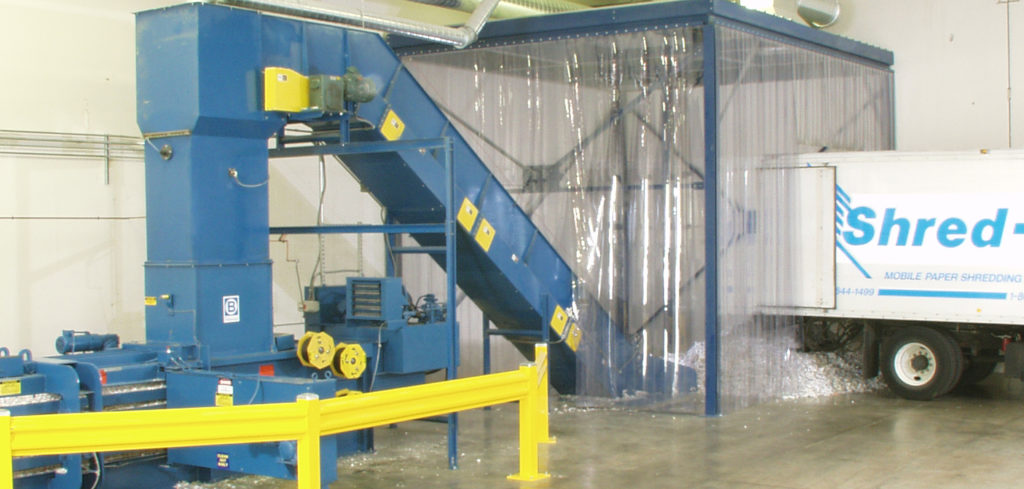As mobile shredding companies grow their business they often think about adding baling to their operations, and for good reason. Baling can be a vital part of your business strategy and allows you to gain control of a valuable by-product of your operations, the shredded paper. Following are five frequently asked questions, or FAQ’s, that you should know if you’re thinking about getting into the baling business.

1) Why should I bale?
The main reasons for baling can be summed up as Revenue, Security and Control. Baled paper commands a higher price per-ton than loose paper. The monthly revenue generated from the sale of the baled material can be significant. When you bale your own paper, you eliminate trips to the recycler so your trucks can service more customers, generating even more revenue. In-house baling adds another layer of security for the customer and eliminates the risk of an un-shredded document falling through the cracks (or blowing away at the recycler’s yard). Baling puts you in control of the paper from the time you pick up and shred through it’s ultimate destination, the paper mill.
2) What kind of baler do I need?
There are two basic kinds of balers used in secure destruction, Vertical and Horizontal. Vertical balers are commonly used to bale OCC (Old Corrugated Containers). The material is hand loaded into the baler hopper and the baling ram moves vertically from top to bottom to compact the material. Wires are fed through slots in the machine and the operator ‘ties off’ the finished bale.
Horizontal balers are used to bale the shredded paper from the shredding trucks. The paper is compressed by a hydraulic ram to produce a long rectangular bale. This type of baler is available as manual-tie or auto-tie. Both types of balers produce heavy, dense, mill sized bales. Auto-tie balers make the truck unloading process fast and efficient, enabling the entire content of the shredding truck to be baled in 20-30 minute. A manual-tie baler will require the truck unloading process to stop in order to tie-off each bale, extending the truck unloading process for up to two hours per truck.
3) How does the paper get from my mobile shredding truck to the baler?
Truck unloading conveyors are specially designed to transfer the shredded paper directly from the truck to the baler without the need to dump paper on the floor or otherwise handle it in the unloading process. A properly designed conveyor system provides a clean, safe and efficient means of transferring the shredded paper to the baler. It will also have dust containment features to ensure that the combustible paper dust does not accumulate in the facility.
4) Should I buy new or used Balers or Baling Equipment?
Used equipment can be an excellent value, with significant upfront cost savings over new equipment, but it is important that you do your homework before investing your hard earned money. Condition, safety and suitability for the application are more important than price, and cost savings will soon disappear if the baler is constantly breaking down. When buying used equipment, it is best to deal with an equipment provider that specializes in baling equipment rather than going to Ebay or other liquidation websites. An experienced baling equipment professional will know how to match a baler to your specific application, have the resources to repair and rebuild the equipment in accordance with the best industry practices, and provide support and service after the sale.
While higher in initial cost, new equipment offers a lot of benefits that can help you achieve a successful baling operation. A new baler will have all the latest productivity, safety and convenience features and generally costs less to operate than used equipment. Most equipment manufacturers offer a comprehensive warranty on their products, which can eliminate worries about frequent breakdowns and high maintenance costs.
New equipment is generally available through manufacturer’s representatives or dealers who can provide all of the services required to make sure that you get into the baling business the right way. Ideally, they will be familiar with your business model and know what is important and relevant to your application. They can also provide ancillary equipment such as conveyors and stationary shredders, along with service after the sale.
5) What else do I need to know?
As a secure destruction professional you’ve got a lot on your plate. Adding baling to your mobile shredding business doesn’t mean you have to become an equipment expert. You just need to find one. The best chance for success comes with establishing a relationship with a trusted vendor that can provide the equipment, services, training and support so you can do what you do best; help your clients protect their confidential information. For more information on Balers and Mobile Shredding Baling Equipment, click here.
_______________________________________________________________
Jeff Dietterich is President of Advanced Equipment Sales. Contact him at 215-723-7200, or AESjeff@aesales.net.
